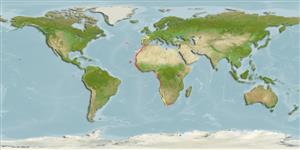>
Carangiformes (Jacks) >
Carangidae (Jacks and pompanos) > Naucratinae
Etymology: Seriola: Latin word diminutive with the meaning of a large earthenware pot (Ref. 45335).
Eponymy: William K Carpenter is a big game fisherman who is a friend of the author. [...] (Ref. 128868), visit book page.
Environment: milieu / climate zone / intervalo de profundidade / distribution range
Ecologia
marinhas bentopelágico; intervalo de profundidade 0 - 200 m (Ref. 26999). Subtropical; 18°C - 27°C (Ref. 43448)
Eastern Atlantic: Bay of Biscay and Agadir, Morocco to Angola, including Cape Verde (Ref. 4233). Migrants were caught around Lampedusa Island (Mediterranean Sea) (Ref. 38310).
Tamanho / Peso / Idade
Maturidade: Lm ? range ? - ? cm
Max length : 72.5 cm TL macho/indeterminado; (Ref. 38310); common length : 40.0 cm TL macho/indeterminado; (Ref. 26999)
Descrição breve
Chaves de identificação | Morfologia | Morfometria
Espinhos dorsais (total) : 8 - 9; Raios dorsais moles (total) : 28 - 33; Raios anais moles: 17 - 21.
Body shape (shape guide): fusiform / normal.
Adults are generally confined only in coastal waters over continental shelf, from the surface to at least 200 m. They feed on squids and fishes. Are confined to areas where surface temperature exceed 25°C, their distribution perhaps influenced by seasonal movements of the 18-27°C water mass along the African coast (Ref. 4233). Eggs are pelagic (Ref. 4233).
Life cycle and mating behavior
Maturidade | Reprodução | Desova | Ovos | Fecundidade | Larvas
Smith-Vaniz, W.F., 1986. Carangidae. p. 815-844. In P.J.P. Whitehead, M.-L. Bauchot, J.-C. Hureau, J. Nielsen and E. Tortonese (eds.) Fishes of the north-eastern Atlantic and the Mediterranean. UNESCO, Paris. vol. 2. (Ref. 4233)
Categoria na Lista Vermelha da IUCN (Ref. 130435: Version 2025-1)
Ameaça para o homem
Reports of ciguatera poisoning (Ref. 30298)
Utilização humana
Pescarias: espécies comerciais; peixe desportivo: sim
Ferramentas
Relatórios especiais
Descarregue XML
Fontes da internet
Estimates based on models
Preferred temperature (Ref.
123201): 15.6 - 24.5, mean 18.7 °C (based on 118 cells).
Phylogenetic diversity index (Ref.
82804): PD
50 = 0.5020 [Uniqueness, from 0.5 = low to 2.0 = high].
Bayesian length-weight: a=0.01445 (0.00636 - 0.03286), b=2.93 (2.73 - 3.13), in cm total length, based on LWR estimates for this (Sub)family-body shape (Ref.
93245).
Nível Trófico (Ref.
69278): 4.6 ±0.59 se; based on food items.
Resiliência (Ref.
120179): Médio, tempo mínimo de duplicação da população 1,4 - 4,4 anos (Preliminary K or Fecundity.).
Fishing Vulnerability (Ref.
59153): Moderate to high vulnerability (49 of 100).
🛈
Nutrients (Ref.
124155): Calcium = 49.3 [30.1, 103.4] mg/100g; Iron = 1.09 [0.61, 1.97] mg/100g; Protein = 18.2 [15.3, 21.1] %; Omega3 = 0.404 [0.247, 0.675] g/100g; Selenium = 35.6 [18.6, 68.4] μg/100g; VitaminA = 52.4 [7.0, 375.9] μg/100g; Zinc = 0.519 [0.365, 0.749] mg/100g (wet weight);
